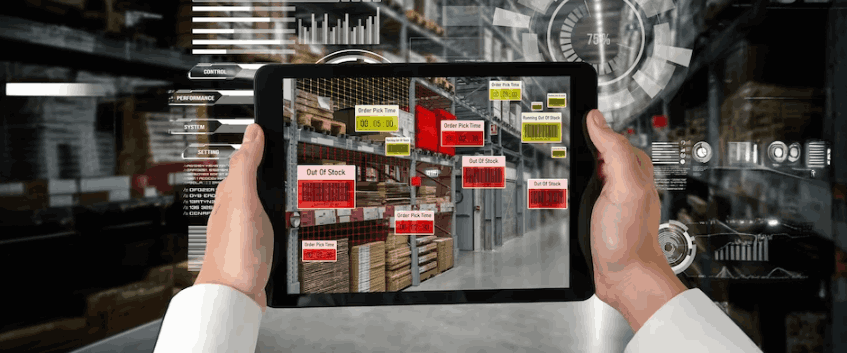
Transform Your Supply Chain Planning and Marketing Strategies with Google Cloud and SAP Integration

Transform Your Supply Chain Planning and Marketing Strategies with Google Cloud and SAP Integration

In a marketplace defined by ever-changing consumer tastes and swift technological advancements, traditional inventory management practices no longer cut it. The sheer cost implications of unsold goods, coupled with an urgent call for sustainability, have thrust real-time inventory positioning to the forefront of modern supply chain management.
But what exactly does real-time inventory positioning mean, and how does it add resilience to modern supply chains?
This comprehensive guide delves into the core of real-time inventory positioning, its essential components, challenges, advantages, and real-world examples. We'll also explore how innovative decision intelligence platforms like Planning in a Box can become a game-changer for companies grappling with inventory challenges.
Retailers in industries like beauty, pharmaceuticals, and food & beverages are staring down $740 billion in unsold goods. This massive figure isn't just about leftover products on shelves. It represents the fundamental challenges in today's supply chain – the need to evolve, adapt, and transform to meet customer needs.
Waste and Environmental Impact: Nearly 8% of surplus stock globally ends up as waste, a staggering $163 billion tossed annually. Overproduction leads to significant loss in various sectors, with the highest in beauty brands, followed by pharmaceuticals and food. Source
Inventory Carrying Costs and Financial Strain: Supply chains are becoming more global and interconnected, with more stakeholders and variables to manage. This complexity makes it more difficult to forecast demand using traditional methods accurately.
Changing Market Dynamics: Market disruptions can have a significant impact on demand for products and services, and companies that are not able to respond quickly to these changes risk losing market share and revenue. Economic factors, such as changes in consumer income or shifts in global trade policies, can impact demand in unexpected ways. Social factors, such as changes in consumer preferences or the emergence of new technologies, can also have a significant impact on demand. Environmental factors, such as natural disasters or pandemics, can disrupt supply chains and lead to significant shifts in demand.
These issues underscore the need for a solution that's not only responsive but anticipatory. Enter real-time inventory positioning, an approach that empowers businesses to align their inventory strategies with actual demand, thereby reducing waste, lowering costs, and improving customer satisfaction.
How Generative AI Is Tackling A $740 Billion Inventory Problem

Real-time inventory positioning is a modern approach to managing stock levels, aligning them seamlessly with current market demand. It's about dynamically adapting inventory based on real-time data, insights, and trends, rather than solely relying on historical data and forecasts. This means constantly updating stock positions to reflect actual market conditions, which is particularly vital in industries where trends can shift dramatically and without notice.
Markets today are fast-paced and can change unexpectedly. Real-time inventory positioning allows businesses to quickly adjust their stock levels in response to these changes. For instance, if a particular product suddenly becomes popular, a business can increase its stock of that product to meet the demand.
With real-time data, businesses can enhance order fulfillment. Since the inventory data is constantly updated, they know exactly what is available for sale. This reduces the lead time - the time between receiving an order and delivering it - because businesses don’t have to rely on predictions; they have actual data on what’s in stock.
Effective real-time inventory positioning means maintaining the right amount of stock. Not too much, to avoid unnecessary costs and storage issues (overstocking), and not too little, to prevent missing out on sales (understocking). This optimization is critical for efficient inventory management within the supply chain.
This approach is not just about how much inventory to keep, but also where to keep it. Strategic placement of inventory across various locations can ensure quicker delivery times and reduced shipping costs, enhancing overall supply chain efficiency.
The Bigger Picture: The ultimate goal here is to create a more responsive, efficient, and customer-oriented supply chain. By having a more accurate and immediate understanding of inventory, businesses can make better decisions, reduce costs, and improve customer satisfaction. This approach aligns inventory management with the dynamic nature of the market, ensuring that businesses can adapt quickly to changes and maintain a competitive edge.
Imagine a popular beauty brand that traditionally launches a new line of summer products based on last year's sales data. They manufacture 500,000 units, expecting a similar response. However, a sudden shift in consumer preferences towards organic products leaves them with 300,000 unsold units, translating to a loss of $3 million.
Contrast this with a competitor who utilizes real-time inventory positioning. They start with a smaller batch of 200,000 units and continuously monitor real-time data from various sources, including social media trends, influencers' activities, competitor launches, and customer feedback. They noticed the organic trend early on and pivoted their production to introduce an organic line, manufacturing an additional 250,000 units.
Here's the outcome:
Traditional Method: 300,000 unsold units, $3 million loss. Real-Time Inventory Positioning: 450,000 units sold, including the new organic line, $4.5 million profit, alignment with consumer demand.
| Aspect | Traditional Inventory Positioning | Real-Time Inventory Positioning |
|---|---|---|
| Data Source | Based on historical data, quarterly reviews | Live data from various sources including social media, competitor analysis |
| Adaptability | Fixed plans, adjustments made in weeks or months | Dynamic plans, adjustments made in hours or days |
| Risk of Overstock/Stockouts | High due to lag in response, leading to financial losses | Significantly reduced by real-time response, leading to financial savings |
| Cost Efficiency | High carrying costs due to overstock, potential loss of millions | Real-time adjustments reduce waste, save costs, enhance profitability |
| Integration with Modern Technologies | Manual monitoring, limited AI and analytics integration | Seamless integration with AI, IoT, real-time analytics, and advanced data platforms |
The shift to real-time inventory positioning from traditional methods is more than just a technological change. It's a fundamental transformation of how businesses approach inventory management, and it requires careful planning and execution. Here's how you can create a real-time inventory positioning system for your business.
Before diving into real-time inventory positioning, assess the current inventory challenges that your business faces.
Is there excessive waste? Are you struggling with stockouts?
Understanding the unique problems within your company will help you set clear objectives for a real-time system.
Real-time inventory positioning thrives on data. Integrating different sources like point-of-sale systems, social media trends, and market data can provide a comprehensive view of consumer demand.
You'll need to develop a robust data foundation to support real-time insights.
Platforms like Planning in a Box, coupled with Generative AI, can support real-time analysis. These tools facilitate easy integration with existing systems and allow for continuous learning and adaptation to market changes.
Designing a dynamic model that can respond to real-time data is critical. Compare this to traditional methods that rely on static forecasting and you'll see the potential for increased efficiency and responsiveness.
For example, a beauty retailer facing a sudden trend change might traditionally end up with $2 million in excess inventory. With real-time positioning, this could be reduced by 40%, aligning stock with actual demand.
Read Case Study: A global beauty brand revolutionized their inventory management with Planning in a Box
Regularly monitor and analyze the real-time inventory positioning system to identify areas for improvement. Constant refinement ensures that the system stays aligned with evolving consumer behavior and market trends

Implementing real-time inventory positioning is a complex undertaking that brings its share of challenges. Here's a closer look at some common hurdles and strategies to overcome them.
Problem: Uniting various data sources like point-of-sale systems, eCommerce platforms, and market trends can be complex and time-consuming.
Solution: Choose a platform with robust integration capabilities, such as Planning in a Box. Investing in a system that can seamlessly connect various data sources will streamline the process.
Problem: Inaccurate or incomplete data can lead to incorrect insights, hampering real-time inventory decision-making.
Solution: Regular data auditing and employing data quality assurance tools can ensure the reliability of the data. Collaboration between business and IT teams can also foster better data management practices.
Problem: Real-time inventory positioning may require a significant shift in organizational culture and processes.
Solution: Establish clear objectives and communicate the benefits of real-time inventory positioning across the organization. Engaging stakeholders early in the process helps in aligning goals and fostering support.
Problem: Not all existing inventory management systems are equipped to handle real-time data processing.
Solution: Consider upgrading or implementing tools that are designed for real-time operations. Platforms that are adaptable and scalable to changing business needs are crucial here.
Problem: Handling real-time data may expose sensitive information, raising compliance and security issues.
Solution: Implement robust security measures and ensure adherence to compliance standards. Collaboration with legal and security experts can be invaluable here.
Problem: Moving to a real-time inventory positioning system requires significant changes in existing workflows and employee responsibilities.
Solution: A thoughtful change management strategy, including training, ongoing support, and clear communication, can facilitate a smoother transition.

Planning in a Box is a cutting-edge decision intelligence platform designed to streamline inventory management in the complex realm of supply chain operations. By integrating a wide array of data sources, this platform employs AI and Generative AI to enhance inventory visibility, optimize positioning strategies, and manage the ebb and flow of inventory effectively. Its powerful analytics capabilities ensure that inventory is positioned in the right locations, balancing the push-pull dynamics of the supply chain while minimizing disruptions.
The platform's ability to connect data from various sources, including warehouse management systems, sales forecasts, and market trends, allows for a comprehensive view of supply and demand. This holistic approach ensures effective inventory positioning, improving overall inventory accuracy and turnover. Whether dealing with types of inventory like raw materials, work-in-progress, or finished goods, Planning in a Box facilitates optimal inventory levels to meet the demands of the market.
| Timeframe | Inventory Challenge Addressed | Impact | ROI |
|---|---|---|---|
| Initial 4 Weeks | Demand Forecasting for Seasonal Products | AI models predict the exact amount of inventory needed, enhancing stock accuracy. | Reduction in overstock and stock-outs by 10-20%, decreasing inventory carrying costs. |
| Next 4 Weeks | Optimizing Safety Stock Levels | Calculating optimal safety stock levels for high-demand products to prevent stockouts. | Further reduction in inventory costs by 5-10% through improved inventory turnover. |
| 8-12 Weeks | Real-Time Inventory Allocation | Analyzing sales data to redistribute inventory efficiently across regions. | Reduction in inter-regional transfer costs by 10%, enhancing regional sales opportunities |
| 12-16 Weeks | Supplier Performance Analysis | Evaluating supplier reliability and lead times to optimize procurement processes. | 5-10% savings in procurement costs, improving supply chain reliability. |
| 16-20 Weeks | Market-Responsive Replenishment | Adjusting inventory replenishment based on real-time market feedback and trends. | Increased responsiveness to market changes, resulting in a 10-15% reduction in clearance costs. |
| 20-24 Weeks | Logistics and Distribution Efficiency | Streamlining logistics operations to optimize distribution channels. | 5-10% reduction in logistics costs due to efficient distribution strategies. |
| 24+ Weeks | Integrated Returns Management | Implementing efficient processes for handling and restocking returns. | 10-15% decrease in return handling costs, boosting overall supply chain efficiency. |
As Planning in a Box is implemented, it enables businesses to start by tackling a specific inventory challenge, such as demand forecasting for a particular product line. As the platform demonstrates its effectiveness, additional use cases, like supplier coordination and logistics optimization, can be progressively integrated into the system. This step-by-step approach not only provides immediate benefits but also paves the way for long-term, sustainable improvements in inventory management.
The platform supports push-pull supply chain strategies, aligning supply with demand, and offers robust warehouse management system integration. The ultimate purpose of inventory – to be available when needed without incurring unnecessary costs – is effectively fulfilled through this AI-driven decision intelligence platform.
How Planning in a Box Boosts Sustainable Inventory Management for ESG Compliance
For companies looking to optimize their inventory, ensure accurate positioning, and improve turnover, Planning in a Box offers a tangible, swift path to achieving these objectives.

Transitioning from traditional to real-time inventory positioning is more than a tech-savvy move; it's an imperative strategy that aligns technology, data, and organizational harmony.
Today's business environment demands swift action, and platforms like Planning in a Box, powered by AI and Generative AI, have made this shift accessible and efficient.
Case studies have shown how, in less than four weeks, businesses can transition from siloed data on spreadsheets to data-driven decision-making with AI.
Companies that embark on this journey don't merely plug the gaping holes in their balance sheets; they place themselves at the forefront of an agile, responsive, and efficient retail landscape. The stakes are high, but the rewards are significant. Supply Chain Teams need to align closely with CFOs, making data-driven, real-time inventory management a financial priority as well as a logistical one.
If you are contemplating this transformation, consider joining our upcoming workshop. Engage in hands-on learning and gain insights from experts who have successfully guided businesses through this critical transition. It's time to move quickly and adapt to the changing demands of the modern world, with tools and strategies designed for today's challenges.
Inventory positioning in the supply chain refers to strategically placing the right inventory in the right locations at the right time. It involves determining the optimal places within the supply chain to store inventory to meet customer demand efficiently while minimizing holding costs.
Effective inventory management is crucial for optimal inventory positioning. It involves tracking of inventory levels, managing inventory flow, and using data analytics to forecast demand accurately. This ensures that inventory is held in the right quantities at locations where it’s most needed, reducing overstock and obsolete inventory.
Businesses can improve inventory positioning by leveraging inventory management platforms like Planning in a Box. This platform helps in accurate inventory tracking, demand forecasting, and providing insights on where to position inventory to maximize availability and minimize costs.
The goal of inventory management, especially during supply chain disruptions, is to maintain enough inventory to meet customer demand without overstocking. It involves adaptive strategies like push-pull supply chain models and effective inventory positioning to ensure business continuity and reduce inventory holding costs.
Inventory management solutions like Planning in a Box optimize inventory storage by providing real-time visibility into inventory levels, enabling businesses to store their inventory strategically. The platform uses AI to predict demand and suggest the appropriate inventory positioning strategy, thus reducing extra inventory and optimizing storage.
Inventory positioning plays a critical role in managing inventory levels. It ensures that the right amount of inventory is available at locations where it is most likely to be needed, thereby reducing the time to meet customer demand and minimizing the costs associated with storing excess inventory.
Yes, Planning in a Box is equipped to handle both push and pull supply chain models. It analyzes market trends and customer data to forecast demand (pull) and also helps in determining the amount of inventory to be produced and stored in advance (push), ensuring an optimal balance.